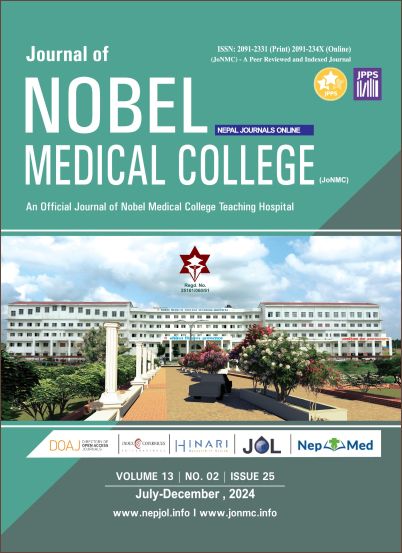The Prediction of Outcomes in Patients Admitted with Traumatic Brain Injury Using the Rotterdam Score
DOI:
https://doi.org/10.3126/jonmc.v13i2.74412Keywords:
Computed Tomography, Glasgow Outcome Scale, Prognosis, Traumatic Brain InjuryAbstract
Background: Traumatic brain injury is a leading cause of mortality and disability worldwide, necessitating accurate tools for prognosis to guide treatment and improve patient outcomes. The Rotterdam computed tomography score, a widely utilized prognostic tool based on cranial computed tomography findings, assesses critical parameters such as basal cistern status, midline shift, and traumatic subarachnoid hemorrhage. This study aimed to evaluate the Rotterdam Score's effectiveness in predicting outcomes among traumatic brain injury patients.
Materials and Methods: A prospective observational study was conducted at Kathmandu Medical College Teaching Hospital, including 120 patients with traumatic brain injury admitted during a three-month period. Rotterdam Scores were calculated from initial cranial computed tomography findings, and outcomes were assessed using the Glasgow Outcome Scale at discharge. Sensitivity, specificity, and predictive values were analyzed, and the receiver operating characteristic curve was used to evaluate the score's diagnostic performance.
Results: Higher Rotterdam Scores correlated significantly with increased mortality and poor functional outcomes (p < 0.001). Patients with scores of 1–2 had a 4% mortality rate, those with scores of 3–4 had a 13% mortality rate, and those with scores of 5–6 had a 46% mortality rate. The Rotterdam Score demonstrated strong predictive value, with an Area Under the Curve of 0.83, sensitivity of 88%, and specificity of 72% for low-risk cases (scores 1–3). High-risk cases (scores 4–6) exhibited sensitivity and specificity of 78.6% and 68.4%, respectively.
Conclusion: The Rotterdam computed tomography score is a robust prognostic tool for predicting mortality and functional outcomes in traumatic brain injury patients. Its strong discriminative ability supports its clinical utility for early risk assessment, aiding decision-making and resource allocation. Further multi-center studies with larger sample sizes are recommended to validate these findings and refine predictive models for traumatic brain injury outcomes
Downloads
Downloads
Published
How to Cite
Issue
Section
License
Copyright (c) 2024 The Author(s)

This work is licensed under a Creative Commons Attribution 4.0 International License.
JoNMC applies the Creative Commons Attribution (CC BY) license to works we publish. Under this license, authors retain ownership of the copyright for their content, but they allow anyone to download, reuse, reprint, modify, distribute and/or copy the content as long as the original authors and source are cited.




